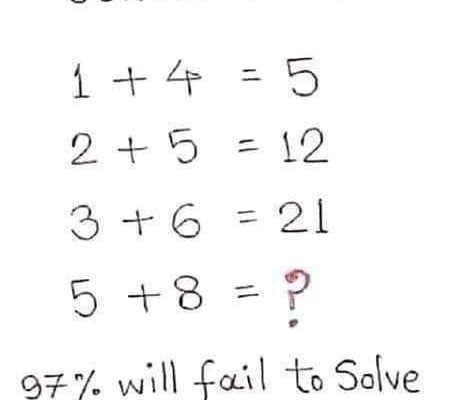Math puzzles are a huge hit on social media, and for a good reason—they draw you in, challenge your mind, and offer a fun distraction from the day-to-day hustle. One particular problem that’s been circulating online recently reads: 230 – 220 x 0.5. At first glance, it seems simple enough, but the twist here is that most people seem to get it wrong, and it’s driving everyone crazy trying to figure out why. Believe it or not, people are claiming the answer is 5. How could that possibly be true? Let’s break it down.

First, let’s talk about why math brain teasers are so popular. People love a good challenge, especially one that can be solved just by using their brains. No calculators, no pen and paper—just mental math. It helps break up the monotony of the day, gives your brain a workout, and makes for a fun way to compete with friends or strangers online. It’s also a great way to remind ourselves of those math concepts we learned in school but may have forgotten over time. Let’s face it—who doesn’t enjoy the satisfaction of getting the answer right, especially when it’s a tricky one?
So, let’s dive into the puzzle:
230 – 220 x 0.5 = ?
At first glance, many people jump straight into the subtraction, seeing 230 – 220 and wanting to solve that right away. But if you do this, you’re forgetting one crucial thing: the order of operations. In math, we follow a specific sequence of steps to solve problems properly, and if you skip any of these steps or do them out of order, you end up with the wrong answer.
In the United States, we use PEMDAS to remember the order of operations. This acronym stands for:
Parentheses, Exponents, Multiplication and Division (from left to right), Addition and Subtraction (from left to right).
Following these rules, we need to complete any Multiplication and Division before we move on to Addition or Subtraction. In the equation 230 – 220 x 0.5, there are no parentheses or exponents, so we go straight to multiplication.
Step 1: Multiply 220 by 0.5
220 x 0.5 = 110
Step 2: Subtract 110 from 230
230 – 110 = 120
So, the correct answer is 120. But that’s not the end of the story here. If the answer is clearly 120, why is everyone talking about 5? This is where the puzzle creator has added a playful twist that catches people off guard.
The Mysterious Number 5: What Does It Mean?
If you’ve seen people saying the answer to this problem is 5, it’s because they are referencing something called a factorial. In math, a factorial is a function that multiplies a number by every positive integer less than itself, all the way down to 1. It’s represented with an exclamation point (!). So, 5 factorial, or 5!, means:
5 x 4 x 3 x 2 x 1 = 120
This is where the twist comes in. The answer we got for 230 – 220 x 0.5 is 120. And 120 is also the result of 5 factorial. In other words:
5! = 120
That’s why some people are saying that the answer is 5—because they are connecting the value 120 to its factorial representation. The exclamation mark here is not about excitement; it’s an actual mathematical symbol that signifies a factorial calculation.
Why Do People Fall for the Trick?
The reason so many people are fooled by this puzzle is that it plays on two things: first, our tendency to forget the rules of order of operations, and second, the concept of factorials, which is not something most people use daily. When the brain teaser claims that “the answer is 5,” it’s meant to be a clever, indirect reference. It’s saying that 120, which we calculated, is 5 factorial—therefore, in a way, the answer can be related to 5.
But at its core, this is a fun example of how numbers can be represented in different forms, and how playing with those forms can create interesting puzzles that are both educational and entertaining.
Why These Math Puzzles Are Addictive
Math brain teasers like this one aren’t just fun—they’re also beneficial. They stimulate our minds, help us think logically, and give us a break from everyday stress. And when shared on social media, they provide a chance to interact with friends, compare answers, and even have a good laugh about the mistakes we make. Plus, there’s always that satisfaction of getting the right answer, especially when you do it without using a calculator.
The trick to solving puzzles like this one is to slow down and remember the basics. Math isn’t just about numbers; it’s also about logic and following rules. And once you understand the principles behind these puzzles, they become much easier to solve.
Final Thoughts
So, if you’re ever faced with a math problem like 230 – 220 x 0.5, take a moment to remember PEMDAS. Solve each step in the proper order, and you’ll get 120 as the correct answer. And if you hear someone say the answer is 5, you’ll now know why—they’re referring to the clever connection to 5 factorial.
Next time you see a brain teaser pop up on your feed, don’t shy away from it. Take the time to solve it, and you might just learn something new—or at least have a fun story to share. After all, math can be pretty exciting when you look at it from the right perspective.
Let me know if there are any more adjustments or further edits you’d like!



